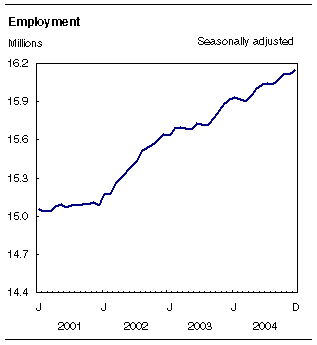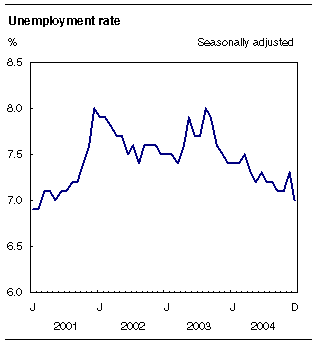
















 |
|
 |                |
Information identified as archived is provided for reference, research or recordkeeping purposes. It is not subject to the Government of Canada Web Standards and has not been altered or updated since it was archived. Please "contact us" to request a format other than those available.

|

Friday, January 7, 2005 Labour Force SurveyDecember 2004Employment increased by an estimated 34,000 in December, pushing the unemployment rate down 0.3 percentage points to 7.0%, the lowest since May 2001. Following a slow start early in the year, employment picked up momentum in the second quarter and over the last four months of 2004. 
The increase in December brought overall employment gains for the year to 228,000 (+1.4%), slightly lower than in 2003 when employment grew by 1.8%. All of the employment gains in 2004 were in full-time jobs and the total number of hours worked rose by 2.2%.
Throughout 2004, the proportion of the employed working-age population (employment rate) remained at or near the record level set in December 2003 (62.7%), as the increase in employment in 2004 just kept pace with population growth. 
Another strong year for construction, continued weakness in manufacturingThe strength in construction employment over the past several years continued in 2004 with an increase of 6.3%, reflecting robust activity related to building permits and housing starts as well as low interest rates. In 2004, employment also increased in professional, scientific and technical services (+6.0%), finance, insurance, real estate and leasing (+5.9%) and natural resources (+3.9%). There was slower growth in retail and wholesale trade (+2.4%) and in health care and social assistance (+1.7%). For the second year in a row, the manufacturing sector turned in a lackluster performance with employment especially hard hit in the second half of 2004, leaving it down 1.2% for the year. Manufacturers had a difficult year as they were confronted with a higher Canadian dollar as well as substantial increases in the price of crude oil and other raw material inputs. The most recent estimates from the Monthly Survey of Manufacturing showed fewer shipments in September and October. Furthermore, exports have fallen as foreign demand for fabricated products has weakened. Employment in the sector is now 4.3% below the most recent peak attained towards the end of 2002. 
Employment increased by 15,000 in professional, scientific and technical services in December, which brought gains over the year to 59,000 (+6.0%). The largest gain in December occurred in Quebec. There was also more employment in natural resources (+7,000) in December, which brought year-to-date gains to 12,000 (+3.9%). The largest increases in December were in Quebec and Newfoundland and Labrador. Over the year, strength in the natural resources sector was concentrated in Alberta and Ontario. Employment in retail and wholesale trade fell by 20,000 in December, partly offsetting gains observed over the previous three months. Despite this decline, employment in the sector was up 2.4% (+59,000) for the year. In December, the number of private sector employees increased by 31,000 and the number of employees in the public sector rose by 21,000. In 2004, employment was up only 0.9% (+91,000) among private sector employees while it grew at a much faster pace of 2.9% (+88,000) among public sector workers. Over the same period, self-employment increased by 2.0% (+48,000). More full-time jobs in 2004In December and in 2004, all of the employment increase was in full-time jobs. Full-time employment rose by 41,000 in December while part-time employment was little changed. The increase in December brought full-time job gains for the year to 258,000 (+2.0%) while part-time employment declined by 1.0% (-30,000). There were 18,000 more adult men working in December, offsetting the decline in November. This increase brought gains for the year to 118,000 (+1.6%), similar to the gain in 2003. The unemployment rate among adult men was little changed in December at 6.0%. Among adult women, an increase of 30,000 full-time jobs in December was offset by a marginal decline in the number of part-time jobs (-17,000), leaving overall employment for this group little changed. In 2004, employment among adult women rose by 1.3% (+84,000), considerably less than the 2.6% increase in 2003. The unemployment rate for this group edged down 0.2 percentage points in December to 5.9%. For the third consecutive month, employment was little changed among youths. However, job gains in the second quarter of the year and during the fall left youth employment up 1.1% (+26,000) since the start of 2004. This compares to a much slower growth rate in 2003 when youth employment was up by only 0.4%. In December 2004, the youth unemployment rate edged down to 12.8%. Job growth in all provinces in 2004In 2004, most provinces had employment growth rates above the national average of 1.4%: New Brunswick (+3.2%), Newfoundland and Labrador (+2.6%), Nova Scotia (+1.9%), British Columbia (+1.9%), Ontario (+1.5%), Manitoba (+1.5%) and Saskatchewan (+1.5%). The growth rate for Prince Edward Island (+2.1%) was also above the national average, due mostly to a strong gain in November. Employment growth in Quebec (+1.0%) and Alberta (+0.9%) was slower than the national average. In British Columbia, employment capped the year with an increase of 17,000 in December and the unemployment rate edged down 0.3 percentage points to 6.1%, the lowest since June 1981. The largest job gains were in business, building and other support services, health care and social assistance and agriculture. While overall employment in the province rose by 39,000 (+1.9%) in 2004, this was much lower than the 4.2% growth the year before. The construction sector was a pillar of job strength for the province in 2004. In December, employment rose by an estimated 5,000 in Newfoundland and Labrador, with the largest increases in natural resources and information, culture and recreation. This increase offset some of the losses observed in recent months and left total gains for the year at 6,000 (+2.6%), well above the 0.3% increase in 2003. The unemployment rate fell 1.2 percentage points in December 2004 to 15.3%. Employment rose by 3,000 in New Brunswick, lowering the unemployment rate from 9.9% in November to 9.5% in December. The employment increase in December brought job gains in the province since the start of the year to 11,000 (+3.2%) and was in sharp contrast to the 1.0% decline in 2003. The bulk of the increase in 2004 was in transportation and warehousing, public administration, educational services and information, culture and recreation. In December, employment was little changed in Quebec. The unemployment rate fell 0.4 percentage points in December to 8.5%, the result of a significant decrease in the number of people searching for work. In 2004, employment in the province grew by 37,000 (+1.0%), just slightly higher than the job growth in 2003 (+0.6%). Job strength in 2004 was primarily in three sectors: finance, insurance, real estate and leasing; business, building and other support services; and in professional, scientific and technical services. These gains were partly offset by losses in educational services and agriculture. Employment in Ontario was also little changed in December and the unemployment rate edged down to 6.8%. In 2004, employment in the province increased by 1.5% (+95,000) whereas in 2003, the increase was stronger at 2.0%. Although the number of factory jobs in the province was little changed in 2004 (-0.4%), it has taken a pronounced downturn since July, down 3.8%. While job growth in Alberta has been strong for over a decade, employment in the province grew by only 0.9% (+15,000) in 2004 and was in sharp contrast to the 2.7% growth of a year ago. In 2004, there were strong gains in construction and in natural resource industries, the likely result of intense oil and gas exploration activities. These increases however were tempered by weakness in manufacturing, especially in the latter part of the year. There was little change in both employment and the unemployment rate in the other provinces in December. Available on CANSIM: tables 282-0001 to 282-0042 and 282-0047 to 282-0095. Definitions, data sources and methods: survey number 3701. Available at 7:00 am on our Web site. From the home page, choose Today's news releases from The Daily, then Latest Labour Force Survey. A more detailed summary, Labour Force Information, is available today for the week ending December 11, 2004 (71-001-XIE, $9/$84). Data tables are also available in the Canadian statistics module of our Web site. The next release of the Labour Force Survey will be on Friday, February 4. For general information or to order data, contact Client Services (1-866-873-8788; 613-951-4090; labour@statcan.gc.ca). To enquire about the concepts, methods or data quality of this release, contact Vincent Ferrao (613-951-4750) or Stéphanie Langlois (613-951-3180), Labour Statistics Division.
| ||||||||||||||||||||||||||||||||||||||||||||||||||||||||||||||||||||||||||||||||||||||||||||||||||||||||||||||||||||||||||||||||||||||||||||||||||||||||||||||||||||||||||||||||||||||||||||||||||||||||||||||||||||||||||||||||||||||||||||||||||||||||||||||||||||||||||||||||||||||||||||||||||||||||||||||||||||||||||||||||||||||||||||||||||||||||||||||||||||||||||||||||||||||||||||||||||||||||||||||||||||||||||||||||||||||||||||||||||||||||||||||||||||||||||||||||||||||||||||||||||||||||||||||||||||||||||||||||||||||||||||||||||||||||||||||||||||||||||||||||||||||||||||||||||||||||||||||||||||||||||||||||||||||||||||||||||||||||||||||||||||||||||||||||||||||||||||||||||||||||||||||||||||||||||||||||||||||||||||||||||||||||||||||||||||||||||||||||||||||||||||||||||||||||||||||||||||||||||||||||||||||||||||||||||||||||||||||||||||||||||||||||||||||||||||||||||||||||||||||||||||||||||||||||||||||||||||||||||||||||||||||||||||||||||||||||
|
|
|